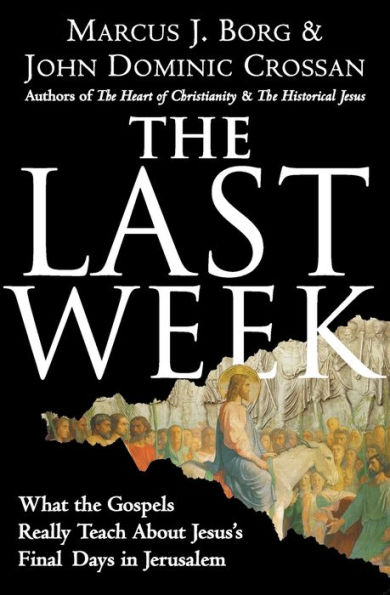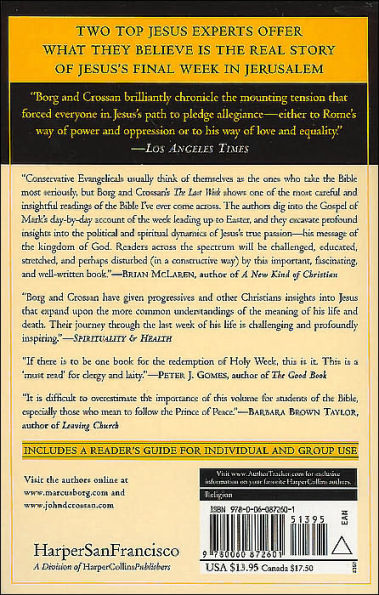Read an Excerpt
The Last Week
What the Gospels Really Teach About Jesus's Final Days in Jerusalem
By Marcus J. Borg HarperCollins Publishers, Inc.
Copyright © 2007 Marcus J. Borg
All right reserved. ISBN: 9780060872601
Chapter One
Palm Sunday
When they were approaching Jerusalem, at Bethphage and Bethany, near the Mount of Olives, he sent two of his disciples and said to them, "Go into the village ahead of you, and immediately as you enter it, you will find tied there a colt that has never been ridden; untie it and bring it. If anyone says to you, 'Why are you doing this?' just say this, 'The Lord needs it and will send it back here immediately.' " They went away and found a colt tied near a door, outside in the street. As they were untying it, some of the bystanders said to them, "What are you doing, untying the colt?" They told them what Jesus had said; and they allowed them to take it. Then they brought the colt to Jesus and threw their cloaks on it; and he sat on it. Many people spread their cloaks on the road, and others spread leafy branches that they had cut in the fields. Then those who went ahead and those who followed were shouting, "Hosanna! Blessed is the one who comes in the name of the Lord! Blessed is the coming kingdom of our ancestor David! Hosanna in the highest heaven!"
Then he entered Jerusalem and went into the temple; and when he had looked around at everything, as it was already late, he went out to Bethany with the twelve.
Mark 11:1 -- 11
Two processions enteredJerusalem on a spring day in the year 30. It was the beginning of the week of Passover, the most sacred week of the Jewish year. In the centuries since, Christians have celebrated this day as Palm Sunday, the first day of Holy Week. With its climax of Good Friday and Easter, it is the most sacred week of the Christian year.
One was a peasant procession, the other an imperial procession. From the east, Jesus rode a donkey down the Mount of Olives, cheered by his followers. Jesus was from the peasant village of Nazareth, his message was about the kingdom of God, and his followers came from the peasant class. They had journeyed to Jerusalem from Galilee, about a hundred miles to the north, a journey that is the central section and the central dynamic of Mark's gospel. Mark's story of Jesus and the kingdom of God has been aiming for Jerusalem, pointing toward Jerusalem. It has now arrived.
On the opposite side of the city, from the west, Pontius Pilate, the Roman governor of Idumea, Judea, and Samaria, entered Jerusalem at the head of a column of imperial cavalry and soldiers. Jesus's procession proclaimed the kingdom of God; Pilate's proclaimed the power of empire. The two processions embody the central conflict of the week that led to Jesus's crucifixion.
Pilate's military procession was a demonstration of both Roman imperial power and Roman imperial theology. Though unfamiliar to most people today, the imperial procession was well known in the Jewish homeland in the first century. Mark and the community for which he wrote would have known about it, for it was the standard practice of the Roman governors of Judea to be in Jerusalem for the major Jewish festivals. They did so not out of empathetic reverence for the religious devotion of their Jewish subjects, but to be in the city in case there was trouble. There often was, especially at Passover, a festival that celebrated the Jewish people's liberation from an earlier empire.
The mission of the troops with Pilate was to reinforce the Roman garrison permanently stationed in the Fortress Antonia, overlooking the Jewish temple and its courts. They and Pilate had come up from Caesarea Maritima, "Caesarea on the Sea," about sixty miles to the west. Like the Roman governors of Judea and Samaria before and after him, Pilate lived in the new and splendid city on the coast. For them, it was much more pleasant than Jerusalem, the traditional capital of the Jewish people, which was inland and insular, provincial and partisan, and often hostile. But for the major Jewish festivals, Pilate, like his predecessors and successors, went to Jerusalem.
Imagine the imperial procession's arrival in the city. A visual panoply of imperial power: cavalry on horses, foot soldiers, leather armor, helmets, weapons, banners, golden eagles mounted on poles, sun glinting on metal and gold. Sounds: the marching of feet, the creaking of leather, the clinking of bridles, the beating of drums. The swirling of dust. The eyes of the silent onlookers, some curious, some awed, some resentful.
Pilate's procession displayed not only imperial power, but also Roman imperial theology. According to this theology, the emperor was not simply the ruler of Rome, but the Son of God. It began with the greatest of the emperors, Augustus, who ruled Rome from 31 BCE to 14 CE. His father was the god Apollo, who conceived him in his mother, Atia. Inscriptions refer to him as "son of God," "lord" and "savior," one who had brought "peace on earth." After his death, he was seen ascending into heaven to take his permanent place among the gods. His successors continued to bear divine titles, including Tiberius, emperor from 14 to 37 CE and thus emperor during the time of Jesus's public activity. For Rome's Jewish subjects, Pilate's procession embodied not only a rival social order, but also a rival theology.
We return to the story of Jesus entering Jerusalem. Although it is familiar, it has surprises. As Mark tells the story in 11:1 -- 11, it is a prearranged "counterprocession." Jesus planned it in advance. As Jesus approaches the city from the east at the end of the journey from Galilee, he tells two of his disciples to go to the next village and get him a colt they will find there, one that has never been ridden, that is, a young one. They do so, and Jesus rides the colt down the Mount of Olives to the city surrounded . . .
Continues...
Excerpted from The Last Week by Marcus J. Borg Copyright © 2007 by Marcus J. Borg. Excerpted by permission.
All rights reserved. No part of this excerpt may be reproduced or reprinted without permission in writing from the publisher.
Excerpts are provided by Dial-A-Book Inc. solely for the personal use of visitors to this web site.






